We have often talked about this city’s proud history of independence that often tripped into dissent and outright opposition against church and state. But after the Reformation the extent to which you disagreed with the Anglican Church would have decided whether or not you could be buried in your local churchyard.
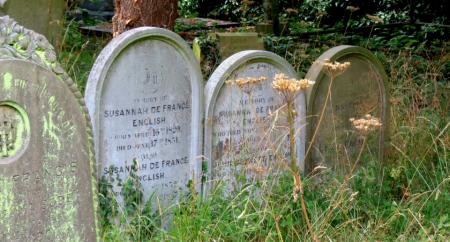
Following the Reformation, Nonconformist factions like the Baptists, Methodists, Presbyterians and Quakers were discriminated against by the Established Church for, despite having to pay church rates, Dissenters were still refused burial in their local churchyard. An Act of 1836 allowed Nonconformists to conduct their own funeral services but it wasn’t until 1880 [1] that they had the right to be buried in a parish church, using their own rites instead of a Church of England service [2].
After the 2011 census, Norwich was reported to be the country’s most godless city [3] but the 1851 census had already shown that the majority of Norwich citizens attended neither church nor chapel [4] and as far back as the early C18 – when dissent could well have been under-reported – as many as 20% of Norwich population were classed as Dissenters [5].
Nonconformist chapels therefore tended to be built with their own burial grounds. The Octagon Chapel in Colegate, built by Thomas Ivory in 1756 to replace a Presbyterian meeting house of 1686, was ‘the first of its kind in England’ [6].

The chapel, which is octagonal rather than cross-shaped, was called ‘The Devil’s Cucumber Frame’ by others. It is now a Unitarian chapel.
To the left of the portico is a gate into the small garden that was the burial ground until 1821; the significance of this dates comes later.
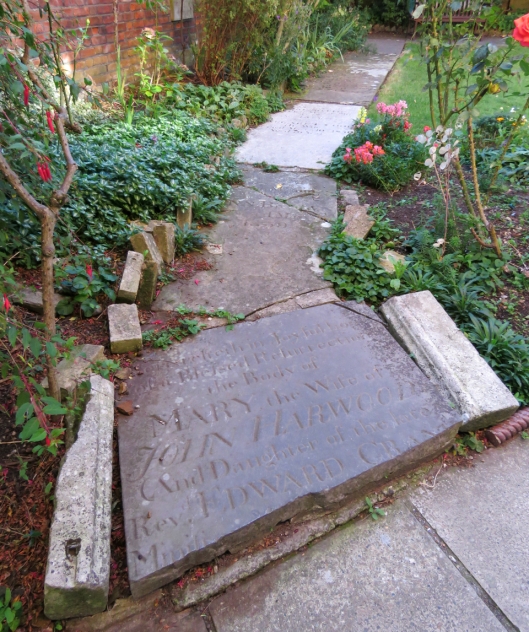
The garden at the OctagonChapel was once its burial ground
In Norwich, The Society of Friends (The Quakers) originally met in private houses or in the open air but in 1676 they bought a modest quarter of an acre in Goat Lane on which to build a Meeting House [7].
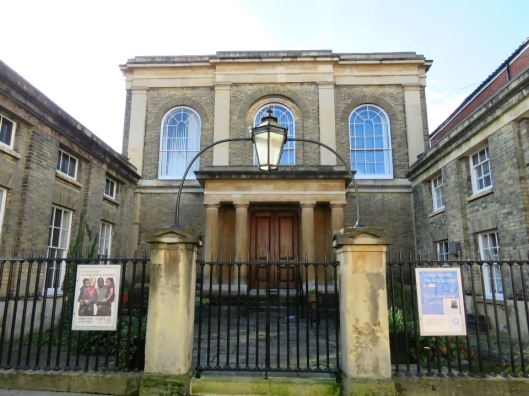
This building of 1826 replaced the C17 building in Goat Lane
By 1700 their congregation had grown to around 500 [7] so the Friends built a second Meeting House in Gildencroft, in Norwich-Over-the-Water (and now Over-the-Ring-Road), next to an acre of land already used for their burial ground.

Simple headstones at the Quakers’ Burial Ground, Gildencroft
However, access to the burial ground via narrow Gildencroft Lane (now Quakers Lane) was difficult for pall bearers …
… and so the Quakers rented land between the burial ground and St Martins (or Whores) Lane off Oak Street to allow horse-drawn wagons to bear the coffin [8]. This strip of land with wagon-turning circle can be seen on a map of 1789, long before the ring road.

The turning circle can be seen below the Friends’ Meeting House (pink), adjacent to their Burial Ground. The amber road at left is now Oak Street. The lane beneath the turning circle is now bisected by the dual carriageway/inner ring road at St Crispin’s Road (red lines). © 2011 Historic Towns Trust
A ghost of the turning circle remains in the form of the crescent-shaped wall adjoining the burial ground. This ‘second’ meeting house was bombed in WWII and the site is now occupied by a children’s centre.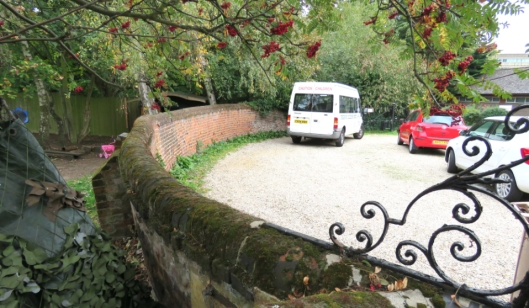
A few yards west of Quakers Lane, in Gildencroft, between the inner ring road and Talbot Square, is the site of a small Jewish cemetery established in 1813; it closed when the corporation cemetery was opened at Earlham (1856). Before this, the county’s Hebrew Congregation used a larger C18 cemetery at the top of Horn’s Lane, off Ber Street [9], on the same side of the city as the synagogue on Synagogue Street (bombed in WWII).
George Plunkett recorded the Jewish Gildencroft cemetery in 1937, five years before the Luftwaffe bombed the Meeting House, which can be seen in the background.
![Oak St Talbot Square Hebrew cemetery [1514] 1937-03-26.jpg](https://colonelunthanksnorwich.com/wp-content/uploads/2018/10/oak-st-talbot-square-hebrew-cemetery-1514-1937-03-26.jpg?w=529)
The old Jewish Cemetery at Gildencroft © georgeplunkett.co.uk

Side-stepping some of the difficulties surrounding dissenting burials the Unitarian minister, Thomas Drummond, established in 1819 The Rosary Cemetery in Thorpe [10]. He may have been motivated by his time in Ipswich when a curate refused a funeral service in the parish church for a young child who Drummond himself had baptised [11]. The Rosary was the first cemetery in the country where anyone could be buried irrespective of religion, without having to be supervised by an Anglican minister. The first occupant was Drummond’s wife, Ann, who was disinterred from the Octagon Chapel.
The Rosary became the resting place for some of the city’s prominent mercantile families, such as the Jarrolds and the Colmans [13].

The City Surveyor JS Benest designed the lodge (not shown) in 1860 but this was redesigned in 1879 by Edward Boardman. Boardman also designed the mortuary chapel (above) and its carriage porch [10] in the prevailing Victorian Gothic style.
Boardman (1834-1910), “who had more effect on the appearance of Norwich than perhaps any other architect” [14], was himself buried at The Rosary.
Boardman’s son Edward Thomas Boardman, also an architect, married Florence, daughter of Jeremiah James Colman (1830-1898),managing director of the family mustard business. In 1898, Jeremiah James’ funeral cortège included his firm’s horse-drawn wagons followed by 1200 workers from the Carrow Works [13]. Although Protestant he made point of holding services for his workers on non-denominational lines [15] and in the same spirit the family’s memorial stones are simply worded: factual and secular. Several members of the Colman family are buried in the family plot. Its Celtic Cross – and there are several at The Rosary – might imply a distancing from Anglican symbolism but inscriptions on the obelisk rectify any such impression with reminders of the Christian afterlife (e.g., ‘I know that my redeemer liveth’).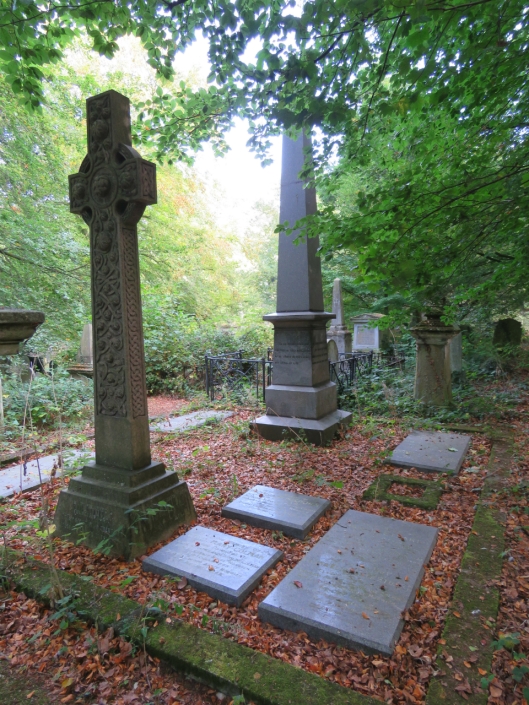
One of the memorial stones unites Jeremiah James and Caroline Colman with their son Alan Cozens-Hardy Colman. Alan died in Egypt and, in his memory, his sisters Ethel and Helen built the pleasure wherry Hathor – the name borrowed from the Nile boat on which he had been convalescing from tuberculosis. Hathor’s interior contains decoration in the Ancient Egyptian style, designed by Boardman.
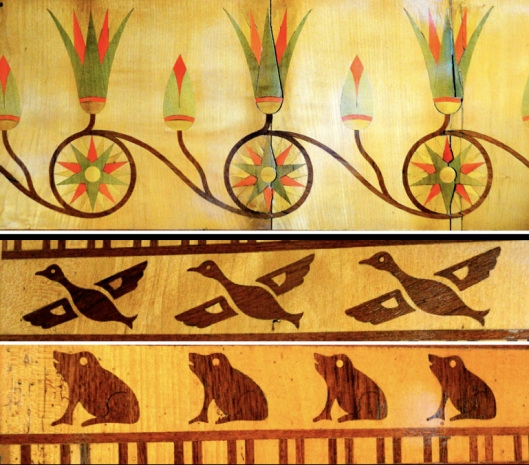
With permission of Peter Cox of www.broadsnet.co.uk ©2018
When Hathor was launched on the Norfolk Broads (1905), Edward Thomas and Florence Boardman’s young daughter Joan (three and a half) released doves [16].
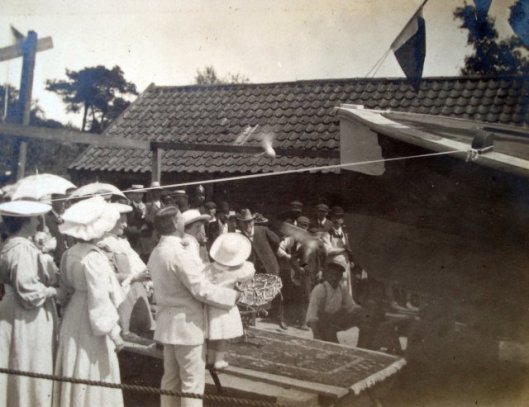
Edward T. Boardman helping daughter Joan to launch Hathor. With permission of © Ludham Community Archive
The many good works that the philanthropic Colmans performed go unsung at The Rosary: you would never guess from the simple inscriptions that in 1923 their daughter Ethel Mary (1863-1948), who campaigned for female suffrage, became the first woman Lord Mayor in Norwich and, indeed, in Great Britain.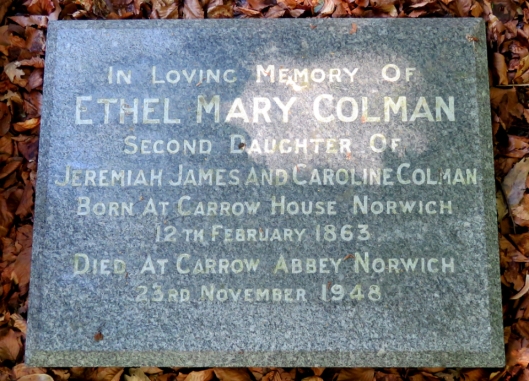
As a memorial, Jeremiah Cozens (d. 1849), whose niece married JJ Colman, has the only cast-iron sarcophagus at The Rosary.
One of the first memorials you see when entering through the carriage porch is dedicated to the Jarrold family of Dutch or Huguenot origin [17]. John Jarrold II started out as a printer and bookseller in Woodbridge, Suffolk. At Wickham Market he was drawn into defending the right to public worship since Dissenters attending services could be stoned by unruly mobs. In 1823, he moved to Norwich where Jarrold & Son opened their new business in London Street where it remains – still selling books nearly 200 years later.
The only mausoleum at The Rosary belongs to Emanuel Cooper, an eminent eye-surgeon (d. 1878). Cooper’s mistress Anne Julia Pearson bore him a daughter – Ada Nemesis – who married John Galsworthy’s cousin Arthur. Ada was not happy in this marriage and entered into a long affair with John, whom she eventually married. Irene in The Forsyte Saga is said to have been modelled on Ada [18].
The angel gazing heavenwards epitomises Victorian sentimentality; it was carved (1898) by the Stanley family of stonemasons in St Stephens Street to commemorate a father and his two wives. 
This cast-iron birdbath (below), with Moorish influences, commemorates the Hines family who ran a foundry (est. 1820) in St Margaret’s Street off St Benedict’s Street. 
The collection of heads is said to represent family members [13].
The ornate memorial below tells the story of John Barker (1837-1897), a Steam Circus Proprietor who, when erecting a railway ride at the Cattlemarket (Plunkett says in Tombland), was fatally crushed between two wagons [13].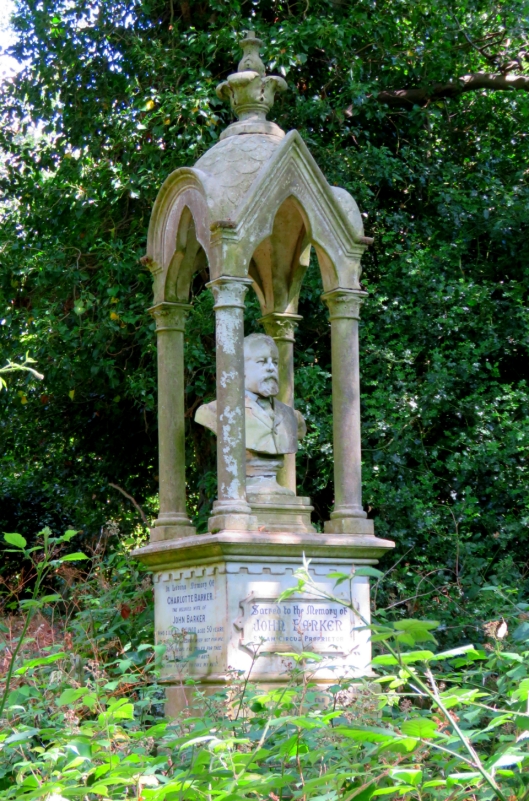
The simple headstone to George Wilde (1825-1887) recalls a man injured in the Charge of the Light Brigade during the Crimean War [13].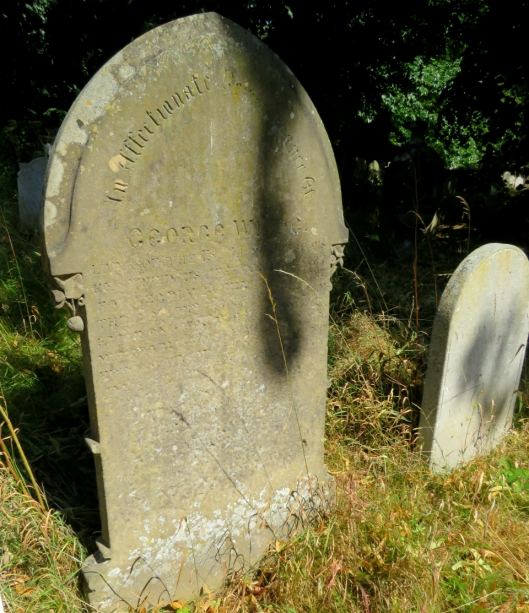
The Rosary is a microcosm of Victorian Norwich in which you will encounter figures whose works can still be seen on walks around the city: Robert Tillyard, for instance, whose leather-currying business gave rise to Tillyard and Howlett, later Howlett and White [19]. Edward Boardman designed Howlett and White’s shoe factory in Colegate, which once employed around 2000 workers [14].
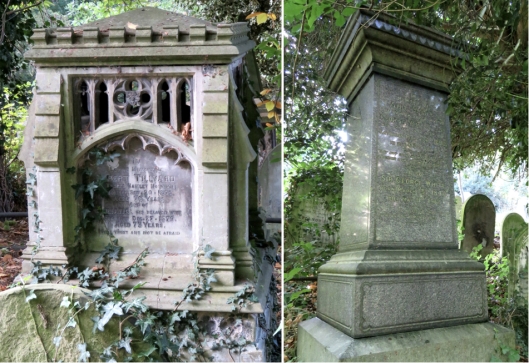
Robert Tillyard (1803-1879 ) and Sir George White (1840-1912)
I also came across an obelisk amongst the undergrowth, dedicated to William Stark. The lettering was indistinct but this was surely the master dyer who stained textiles Norwich Red and who – as mentioned in a recent post [20] – made the Wensum run scarlet when he emptied his vats. 
In 1848-9 Norwich suffered a cholera epidemic and from 1855 the Home Secretary banned burial in the city’s overflowing churchyards [21]. But as far back as 1671 the diarist John Evelyn had written: I observed that most of [Norwich’s] church yards (though some of them large enough) were filled up with earth, or rather the congestion of dead bodies one upon another, for want of earth, even to the very top of the walls, and some above the walls, so as the churches seemed to be built in pits [12].
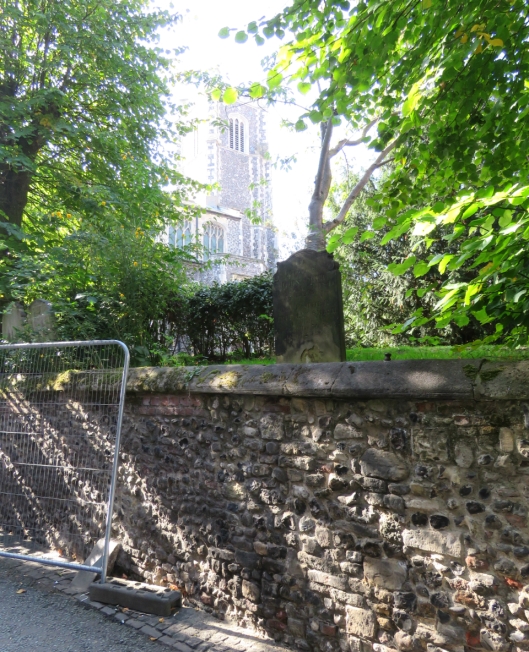
The raised churchyard of St John Maddermarket
In 1856 the City established a public cemetery at Earlham and from the beginning it had space for unconsecrated as well as consecrated burial. The original Gothic-styled twin chapels for Anglican and Nonconformist burials were lost when the crematorium was built but Roman Catholic and Jewish mortuary chapels remain.
Possibly the most striking monument in the older C19 section marks the grave of the horse dealer, John Abel (1800-1883). 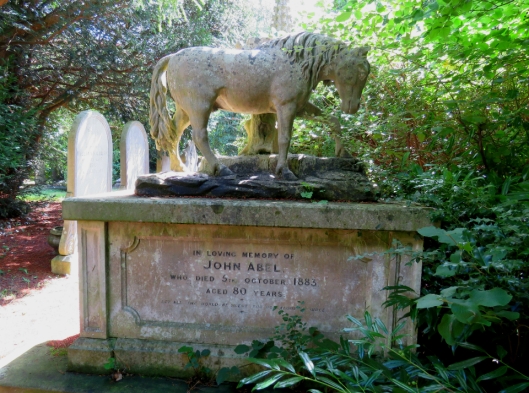
In several posts I have mentioned the Bullard family of brewers [22]; their plot is outlined by cast-iron railings. Could these have been made by the Barnard Bishop and Barnard foundry just across the river from Bullards’ Anchor Quay Brewery?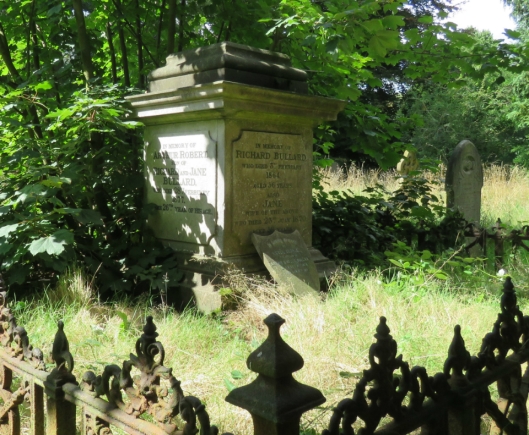
While the versatile and prolific architect Edward Boardman is buried amongst his wealthy relatives in The Rosary his rival, George Skipper – who designed the city’s pops of Victorian genius, like the Royal Arcade, and the Marble Hall for Norwich Union [23] – is buried in far less prepossessing style at Earlham. Skipper’s (1856-1948) failed investments made for a poor retirement so at the age of 78 was still grinding out plans, like those for the roads and drains of the Christchurch Road extension [24]. A member of the Plymouth Brethren, Skipper married three times, lived to 93, and is buried with his first wife. It took some time for me to find George John Skipper’s grave for, in the five years since Françoise Donovan’s photograph, lead lettering had been lost from his name on the gravestone. “And there, sadly, lie the remains of this visionary architect who left us a unique legacy” [25].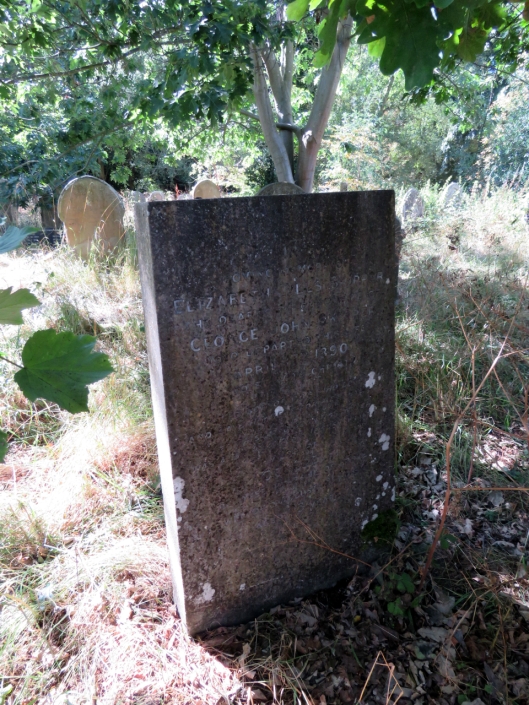
©2018 Reggie Unthank
Sources
- http://www.legislation.gov.uk/ukpga/Vict/43-44/41
- Janet Lister (1993). Nine Nonconformists Burial Grounds 1750-1900. MA thesis UEA.
- https://www.bbc.co.uk/news/av/uk-20685778/census-2011-is-norwich-the-most-godless-city
- Clyde Binfield (2004). Church and Chapel p412. In, ‘Norwich since 1550’, edited by Carole Rawcliffe. Pub: Hambledon and London.
- Kathleen Wilson (1995). The sense of the people: politics, culture and imperialism in England, 17-15-1785. Pub: Cambridge University Press
- http://www.norfolkchurches.co.uk/norwichoctagon/norwichoctagon.htm.
- http://discovery.nationalarchives.gov.uk/details/r/88d35bcc-0261-4bba-95d7-70d628044a78
- http://www.staugustinesnorwich.org.uk/History_-_The_Quakers.html and http://www.staugustinesnorwich.org.uk/History_-_Placenames.html
- http://www.georgeplunkett.co.uk/Norwich/monumentsandmemorials.htm See also: http://www.staugustinesnorwich.org.uk/History_-_The_Jewish_Cemetery.html
- https://historicengland.org.uk/listing/the-list/list-entry/1001568
- Nick Williams (2012). Buried at the Rosary. Pub: Nick Williams.
- John Evelyn. (1818) The Diary of John Evelyn vol 2 (1665-1702). Ed Wm Bray. Online: http://www.gutenberg.org/files/42081/42081-h/42081-h.htm
- Nick Williams, Jim Marriage and June Marriage (2005). The Rosary Cemetery, Norwich: A Place of Decent Interment. Pub: Friends of the Rosary.
- https://colonelunthanksnorwich.com/2016/07/28/norwichs-pre-loved-buildings/
- Jeremiah James Colman, a Memoir by One of his Daughters (1905). Available online as: https://archive.org/stream/jeremiahjamesco01colmgoog/jeremiahjamesco01colmgoog_djvu.txt
- http://www.ludhamarchive.org.uk/bdmstori.htm
- The House of Jarrolds, 1823-1923 (established 1770). Pub 1924 by The Empire Press, Norwich. Online: https://archive.org/stream/houseofjarrolds100jarr/houseofjarrolds100jarr_djvu.txt
- https://en.wikipedia.org/wiki/John_Galsworthy
- https://norfolkrecordofficeblog.org/2016/11/10/norwich-shoemaking-from-howlett-and-white-to-norvic/
- https://colonelunthanksnorwich.com/2018/07/15/the-bridges-of-norwich-1-the-blood-red-river/
- https://en.wikipedia.org/wiki/Earlham_Road_Cemetery,_Norwich
- https://colonelunthanksnorwich.com/2017/09/15/bullards-brewery/
- https://colonelunthanksnorwich.com/2017/02/15/the-flamboyant-mr-skipper/
- Clive Lloyd (2017). Colonel Unthank and the Golden Triangle. See: https://colonelunthanksnorwich.com/unthank-book/
- Françoise Donovan (2013). Norwich Lives: Selected Graves from Earlham Cemetery. Pub: Elysé Publications.
Thanks to: Alan Theobald, my guide around The Rosary and Earlham cemeteries; Stuart McClaren local historian in the St Augustine’s/Gildencroft area http://www.staugustinesnorwich.org.uk/index.html; Peter Cox of Broadsnet http://www.broadsnet.co.uk/waterways/; Nigel Pope of the Ludham Community Archive http://www.ludhamarchive.org.uk/ ; Jonathan Plunkett of www.georgeplunkett.co.uk; and the staff of the Norfolk Heritage Centre at the Norfolk and Norwich Millennium Library.

Have just help publish a book on Graveyard Symbolism (The Graveyard and Cemeteries of Gt Yarmouth).
If you let me have your address I can drop a copy in to you.
Best Selwyn
LikeLike
Thank you Selwyn, I look forward to reading it.
LikeLike
Well up to your usual standard. I must admit that it is a long time since I visited the Rosary – my wife’s maternal grandfather is buried there but I feel that Boardman excelled himself. Last time I passed the Quaker cemetery the gates were locked but if it is open it repays a visit – the dates on the gravestones are expressed rather differently to the common way
Don Watson
LikeLike
My ancestors are buried some distance away and I envy (if that is the right word here) your connection with The Rosary. The Quaker Burial Ground in Gildencroft is rather more plain but is nonetheless a beautiful place; it’s a huge pity that the gates are now locked due to its mis-use.
LikeLike
Thank you – yet another good read!
LikeLiked by 1 person
Thank YOU. Kind regards, Reggie
LikeLiked by 1 person
Excellent and truly fascinating article. Well done! Thanks for sharing it with us.
LikeLike
I appreciate the kind words from a fellow blogger, William.
LikeLike
Interesting article. Thank you.
Have you seen a pamphlet written by Judith Havens about John Abel, horse trader? The horse statue caught her imagination and led to her research into the life of an energetic and fascinating Norwich figure. Apologies if you have read it. I know you can’t cover everything in your articles.
LikeLike
Hello Ann, Yes, I know Judith’s book well. I try – perhaps not always successfully – to keep my posts to a manageable size so was unable to make a side-trip into Abel’s life. Judith Havens’ in-depth (75 pages plus photos) research into ‘John Abel: Horse-dealer of Norwich’ (2014) is a lovely example of local history and I can thoroughly recommend it. Kind regards, Reggie.
LikeLike
Excellent. Long ago I worked in the studio at Tibbenham Advertising at 113(?) Thorpe Road and many a lunch hour was spent exploring The Rosary.
The studio was in the little tower block at the back and was level with and overlooked it. From there, at this time of year in the late afternoon when the sky was clear and with the sun low in the sky, many of the grave stones glow an eerie gold.
Would they have been aligned to do this on purpose? I can find no evidence that they were – but read that in some Jewish Cemeteries bodies are buried with their feet facing the entrance symbolizing that they’ll leave at the time of the resurrection.
LikeLike
Hello Geoff, Thanks for the fascinating question. I don’t recall seeing that many Jewish gravestones to account for a uniform-ish alignment relative to the sun. To double-check I just read about grave alignment on the site below. In summary, after investigating several burial sites, the writer says that there is rarely any uniform alignment and this applies to Anglican, Non-Denom, Jewish “and if it’s anything to do with the Victorians, forget it.” See: https://www.naturalnavigator.com/news/2013/02/church-graveyard-alignment-trends-west-east. Kind regards, Reggie
LikeLiked by 1 person
Another fascinating post. Thanks for the location education Reggie!
LikeLike
My pleasure!
LikeLike
So interesting as to be expected. These posts keep the high standards of all that came before. I love the reminders of how Norwich has been such a distinct and non-conformist city throughout its history. So many national firsts happened here, and Norfolk in general. Thanks Reggie
LikeLike
There are so many examples of this city’s independence. I am particularly fascinated by Kett’s Rebellion and may come back to this sometime. Thank you Daniel
LikeLike
Fascinating, totally fascinating. My great grand parents are both buried at the Rosary Cemetery. I had deceased relatives living on Riverside Road with more family living in Lollards Rd which has an even more fascinating history…. The Lollards
LikeLike
Hello Julie, The Lollards … I have touched upon them a few times. We have, now, no sense of the depth of belief, what it was like to believe so absolutely that you would accept being consigned to the flames. I hope to return to his some time. Thank you for following me.
LikeLike
Such an interesting post! Well researched and illustrated as always, your posts are a pleasure to read and looked forward to.
LikeLike
I appreciate the kind words Clare.
LikeLiked by 1 person
Fantastic.
LikeLike
Thank you Stu. Your last blog on Anglia Square is required reading for anyone interested in knowing the background to the second redevelopment of this site on the north side of the river. https://themilecrossman.wordpress.com/2018/12/
LikeLike
Pingback: The Norwich School of Painters | COLONEL UNTHANK'S NORWICH
Pingback: Street names | COLONEL UNTHANK'S NORWICH
Pingback: Street Names #2 | COLONEL UNTHANK'S NORWICH
Pingback: Sculptured Monuments #2 | COLONEL UNTHANK'S NORWICH
I was an an attender at Goat Lane for a few years before the leaving Norwich for the Midlands in 1982. I seem to recall the Meeting, in common with all the Dissenting places of worship, having had its own burial ground at the back (off to the left in your picture) in the early days prior to the Gildencroft- as with the Octagon Chapel it had been a garden for generations with just the odd tombstone as a clue. For many years it would have been overlooked by the rear of the neighbouring Hippodrome. I think that the garden has now become a car park, as, of course, did the Hippodrome back in the ’60s. The change in the law from 1880 is mentioned somewhat sardonically in Arnold Bennett’s “Clayhanger” Hitherto,across the so-called Five Towns, Nonconformists must have outnumbered Anglicans to the extent of the tail seeming to wag the dog!
LikeLiked by 1 person
I was unaware that garden behind the Quaker meeting house was once its burying ground. The Gildencroft ‘extension’ is a wonderful site but, sadly, now locked because of misuse.
LikeLike
“But, in spite of numerous attempts, nobody had contrived to make England see that her very existence would not be threatened if museums were opened on Sundays, or that Nonconformists might be buried according to their own rites without endangering the constitution.” “Clayhanger” Arnold Bennett “Father and Son after Seven Years”.
Yes, the Gildencroft is a lovely open space easily on a par with any of Norwich’s other churchyards. Is the garden at “Goats” actually still there, by the way? I’d heard rumours it had been tarmacked over.
LikeLike
The meeting house now has car parking to the south and west.
LikeLiked by 1 person